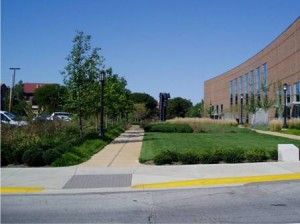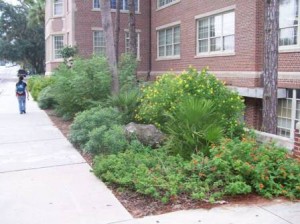We have much more to do and your continued support is needed now more than ever.
Going Native: Rooting Campus Landscape Planning in Low-Energy Native Plants

Native plants bestow tremendous benefits on communities and natural habitats, and are the superior choice when it comes to reducing a school’s impact on the climate. However, they are in danger nationwide. According to one report out of UC Berkeley, two-thirds of California’s native plants could suffer more than an 80% reduction in geographic range in the next 90 years, which could lead to their demise if they can’t keep pace with the rapidly changing climate. The University of Florida is one of many institutions making changes in its landscaping plans to prevent such an outcome.
Low mowing and less maintenance
Planting with indigenous species often lightens the load on landscaping staff. Many native grasses, for instance, grow more slowly and to shorter heights than non-native varieties. When used for turf on university and college campuses, these grasses require less mowing, and therefore have lower fuel requirements. Likewise, trees and shrubs of native varieties need less human intervention to maintain their appearance, which usually means less work for powered landscaping tools.
Purdue University (West Lafayette, IN) is using native plants to restore natural habitats on their campus and cut fuel consumption. In one project in particular, an upland site of fragmented forested woodlots is being reconnected through large native plantings, including an extensive wildflower area. This open area, that would otherwise be a patch of lawn, is now reverting to its prairie roots and will help to reduce Purdue’s landscaping fuel costs as a no-mow area.
Although Purdue doesn’t currently have a formal plan for promoting native plants, the University of Florida (UFL) has a relatively mature native plant program. For the past 20 years, most plants added to the institution’s landscape have been native or low-impact. This is due in large part to UFL’s Master Plan which includes a concerted effort to remove invasive non-native plant species and replace them with Florida’s native plants.
“We don’t quite use 100% native plants in our landscape design,” comments Martin Werts, Landscaping/Grounds Superintendent at UFL, “but we come pretty close. If it’s not a native plant, more than likely it’s a xeriscape plant [those that survive without supplemental irrigation], but for a few exceptions when a donor or professor requests a particular non-native plant.”
Plant species, from trees to turf, are all part of the native plant program. St. Augustine, one of the most common grass species used throughout Florida and one that currently accounts for half of the lawn on campus, is a water-loving, pest-prone turf that’s slowly being phased out. It’s being replaced with one of three slow-growing, low-water, low-chemical lawns (though these aren’t strictly native species): Zoysia, Bahia Grass, or Centipede. “It’s amazing to compare Zoysia side-by-side St. Augustine, ” says Werts. “The St. Augustine will grow twice as fast!”

And any time a new building project is in the works, existing native plants are taken into consideration. All trees three inches or taller must be carefully relocated and fines are often levied against the contractors to provide mitigation for the loss. These fines feed the school’s Heritage Tree Fund that’s used to advance native plant restoration projects on campus.
Additionally, there are now many designated conservation areas at UFL where non-natives are being systematically removed and replaced by native plantings. Interpretive kiosks are installed in these areas to educate passersby about the plants used in the landscape and local wildlife.
Light on water and chemical consumption
In addition to fuel savings, water and chemical requirements for native species are significantly reduced, given their ability to thrive in the wild with no human support. Like all domestic and commercial water consumption, the use of water for irrigation requires relatively large amounts of energy. In America, our 60,000 water systems and 15,000 wastewater systems use about 75 billion kWh every year (3% of annual electricity consumption nationwide) for source and conveyance, treatment, and distribution.
Additionally, native trees, shrubs, and turf require little to no fertilization and very modest pest control measures, if any. The energy benefits? Given that producing commercial fertilizers and pesticides uses about one-third of the energy consumed in the U.S. agriculture industry, this is another potential boon for institutions looking for ways to reduce indirect contributions to climate change.
Synthetic chemicals have one other climate impact: when the nitrogen in synthetic and organic fertilizers is added to landscapes across the country, it breaks down through microbial processes to produce nitrous oxide (N2O), a greenhouse gas that’s 300 times more potent than carbon dioxide in its heat-trapping ability. Nitrogen fertilization of soils accounted for nearly 60% of U.S. nitrous oxide emissions in 2007.
The native plants used in North Carolina State University’s (NCSU) landscaping are installed without irrigation and have low fertilization requirements, as well as fewer disease and insect infestations. Used throughout campus, the grounds management team has realized water and chemicals savings by hand-watering the native plants for the first summer until they are established, and then leaving them to their own devices.
A native prairie planting at Purdue was installed by family members of a deceased Purdue student. (Don Staley/Purdue University) In addition to choosing natives for their low maintenance requirements, NCSU also uses native species to educate students and the public. Chris Moorman, Coordinator of the Fisheries and Wildlife Sciences Program at NCSU and former Extension Wildlife Specialist, worked extensively on a 0.10-acre demonstration garden as well as a Going Native educational website for the community. With over 50 native plant species incorporated into the project, it has become a very inviting habitat for native wildlife and butterflies.
Growing more efficiently with native plants
Using native plant species isn’t without problems, however. NCSU staff have found that restricting plant choice to native species can be a bit limiting, especially when there are so many aesthetic and design goals for the landscape.
Tracking their effect on climate change is also a challenge. Despite all that native plants have to offer, none of the institutions featured here have yet to track reductions in climate emissions from native plant choices. True, many see the inherent benefits of incorporating native plants in their landscaping design guidelines–in fact, according to the recently released NWF Campus Environment 2008 Report Card, a full 72% of the 1,000 schools surveyed have a native or low-maintenance vegetation program in place, which is up 21% from 2001. Yet like many fringe climate issues, most have yet to thoroughly explore how these leafy environmental heroes fit into their overall sustainability plans.




















